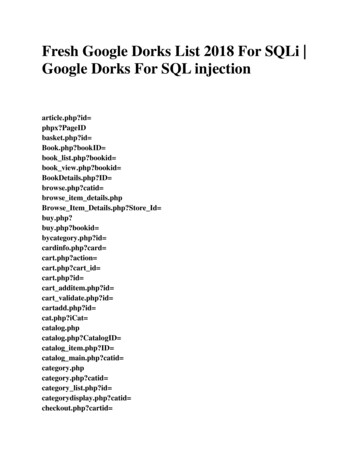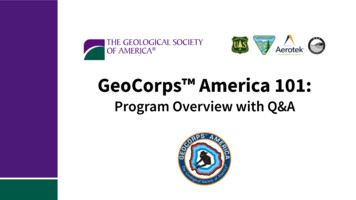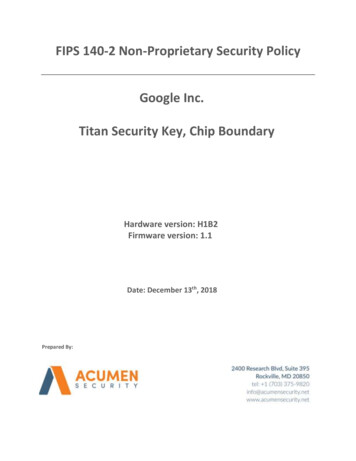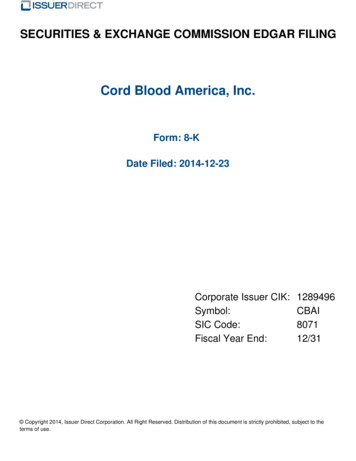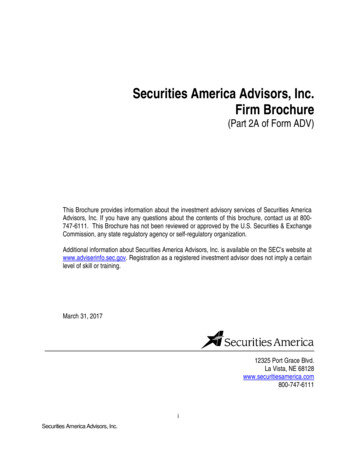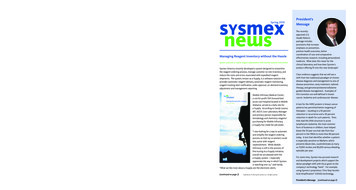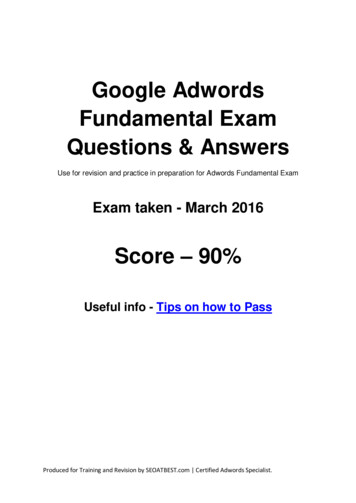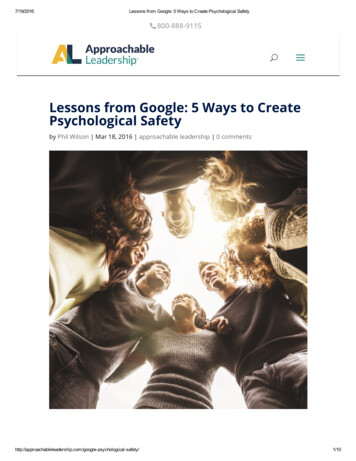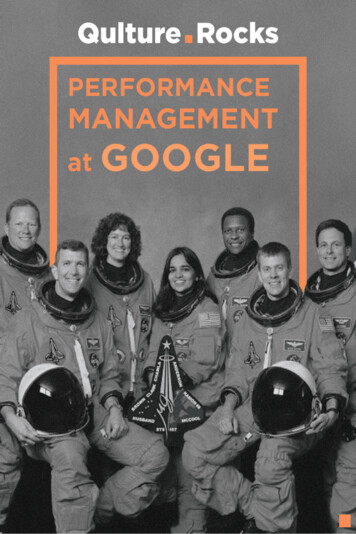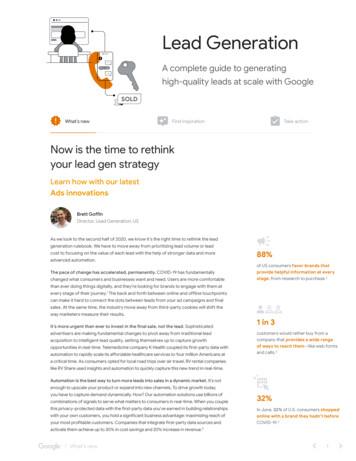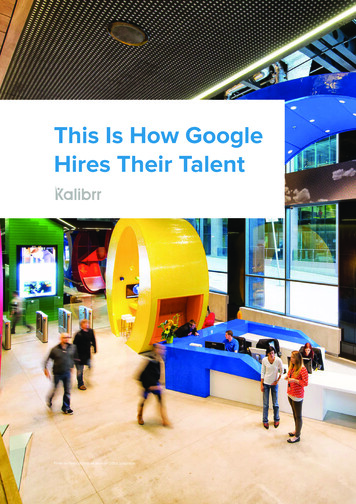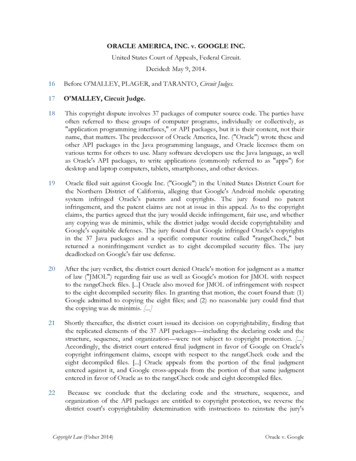
Transcription
ORACLE AMERICA, INC. v. GOOGLE INC.United States Court of Appeals, Federal Circuit.Decided: May 9, 2014.16Before O'MALLEY, PLAGER, and TARANTO, Circuit Judges.17O'MALLEY, Circuit Judge.18This copyright dispute involves 37 packages of computer source code. The parties haveoften referred to these groups of computer programs, individually or collectively, as"application programming interfaces," or API packages, but it is their content, not theirname, that matters. The predecessor of Oracle America, Inc. ("Oracle") wrote these andother API packages in the Java programming language, and Oracle licenses them onvarious terms for others to use. Many software developers use the Java language, as wellas Oracle's API packages, to write applications (commonly referred to as "apps") fordesktop and laptop computers, tablets, smartphones, and other devices.19Oracle filed suit against Google Inc. ("Google") in the United States District Court forthe Northern District of California, alleging that Google's Android mobile operatingsystem infringed Oracle's patents and copyrights. The jury found no patentinfringement, and the patent claims are not at issue in this appeal. As to the copyrightclaims, the parties agreed that the jury would decide infringement, fair use, and whetherany copying was de minimis, while the district judge would decide copyrightability andGoogle's equitable defenses. The jury found that Google infringed Oracle's copyrightsin the 37 Java packages and a specific computer routine called "rangeCheck," butreturned a noninfringement verdict as to eight decompiled security files. The jurydeadlocked on Google's fair use defense.20After the jury verdict, the district court denied Oracle's motion for judgment as a matterof law ("JMOL") regarding fair use as well as Google's motion for JMOL with respectto the rangeCheck files. [.] Oracle also moved for JMOL of infringement with respectto the eight decompiled security files. In granting that motion, the court found that: (1)Google admitted to copying the eight files; and (2) no reasonable jury could find thatthe copying was de minimis. [.]21Shortly thereafter, the district court issued its decision on copyrightability, finding thatthe replicated elements of the 37 API packages—including the declaring code and thestructure, sequence, and organization—were not subject to copyright protection. [.]Accordingly, the district court entered final judgment in favor of Google on Oracle'scopyright infringement claims, except with respect to the rangeCheck code and theeight decompiled files. [.] Oracle appeals from the portion of the final judgmententered against it, and Google cross-appeals from the portion of that same judgmententered in favor of Oracle as to the rangeCheck code and eight decompiled files.22Because we conclude that the declaring code and the structure, sequence, andorganization of the API packages are entitled to copyright protection, we reverse thedistrict court's copyrightability determination with instructions to reinstate the jury'sCopyright Law (Fisher 2014)Oracle v. Google
infringement finding as to the 37 Java packages. Because the jury deadlocked on fair use,we remand for further consideration of Google's fair use defense in light of thisdecision. With respect to Google's cross-appeal, we affirm the district court's decisions:(1) granting Oracle's motion for JMOL as to the eight decompiled Java files that Googlecopied into Android; and (2) denying Google's motion for JMOL with respect to therangeCheck function. Accordingly, we affirm-in-part, reverse-in-part, and remand forfurther proceedings.BACKGROUNDA. The Technology25Sun Microsystems, Inc. ("Sun") developed the Java "platform" for computerprogramming and released it in 1996.[1] The aim was to relieve programmers from theburden of writing different versions of their computer programs for different operatingsystems or devices. "The Java platform, through the use of a virtual machine, enable[d]software developers to write programs that [we]re able to run on different types ofcomputer hardware without having to rewrite them for each different type." [.] WithJava, a software programmer could "write once, run anywhere."26The Java virtual machine ("JVM") plays a central role in the overall Java platform. TheJava programming language itself—which includes words, symbols, and other units,together with syntax rules for using them to create instructions—is the language inwhich a Java programmer writes source code, the version of a program that is "in ahuman-readable language." [.] For the instructions to be executed, they must beconverted (or compiled) into binary machine code (object code) consisting of 0s and 1sunderstandable by the particular computing device. In the Java system, "source code isfirst converted into bytecode,' an intermediate form, before it is then converted intobinary machine code by the Java virtual machine" that has been designed for that device.[.] The Java platform includes the "Java development kit (JDK), javac compiler, toolsand utilities, runtime programs, class libraries (API packages), and the Java virtualmachine." [.]27Sun wrote a number of ready-to-use Java programs to perform common computerfunctions and organized those programs into groups it called "packages." Thesepackages, which are the application programming interfaces at issue in this appeal, allowprogrammers to use the prewritten code to build certain functions into their ownprograms, rather than write their own code to perform those functions from scratch.They are shortcuts. Sun called the code for a specific operation (function) a "method."It defined "classes" so that each class consists of specified methods plus variables andother elements on which the methods operate. To organize the classes for users, then, itgrouped classes (along with certain related "interfaces") into "packages." [.] The partieshave not disputed the district court's analogy: Oracle's collection of API packages is likea library, each package is like a bookshelf in the library, each class is like a book on theshelf, and each method is like a how-to chapter in a book. [.]28The original Java Standard Edition Platform ("Java SE") included "eight packages ofpre-written programs." [.] The district court found, and Oracle concedes to someextent, that three of those packages—java.lang, java.io, and java.util—were "core"Copyright Law (Fisher 2014)Oracle v. Google
packages, meaning that programmers using the Java language had to use them "in orderto make any worthwhile use of the language." [.] By 2008, the Java platform had morethan 6,000 methods making up more than 600 classes grouped into 166 API packages.There are 37 Java API packages at issue in this appeal, three of which are the corepackages identified by the district court.[2] These packages contain thousands ofindividual elements, including classes, subclasses, methods, and interfaces.29Every package consists of two types of source code— what the parties call (1)declaringcode; and (2) implementing code. Declaring code is the expression that identifies theprewritten function and is sometimes referred to as the "declaration" or "header." Asthe district court explained, the "main point is that this header line of code introducesthe method body and specifies very precisely the inputs, name and other functionality."[.] The expressions used by the programmer from the declaring code command thecomputer to execute the associated implementing code, which gives the computer thestep-by-step instructions for carrying out the declared function.30To use the district court's example, one of the Java API packages at issue is "java.lang."Within that package is a class called "math," and within "math" there are severalmethods, including one that is designed to find the larger of two numbers: "max." Thedeclaration for the "max" method, as defined for integers, is: "public static int max(int x,int y)," where the word "public" means that the method is generally accessible, "static"means that no specific instance of the class is needed to call the method, the first "int"indicates that the method returns an integer, and "int x" and "int y" are the twonumbers (inputs) being compared. [.] A programmer calls the "max" method by typingthe name of the method stated in the declaring code and providing unique inputs forthe variables "x" and "y." The expressions used command the computer to execute theimplementing code that carries out the operation of returning the larger number.31Although Oracle owns the copyright on Java SE and the API packages, it offers threedifferent licenses to those who want to make use of them. The first is the GeneralPublic License, which is free of charge and provides that the licensee can use thepackages—both the declaring and implementing code—but must "contribute back" itsinnovations to the public. This arrangement is referred to as an "open source" license.The second option is the Specification License, which provides that the licensee can usethe declaring code and organization of Oracle's API packages but must write its ownimplementing code. The third option is the Commercial License, which is for businessesthat "want to use and customize the full Java code in their commercial products andkeep their code secret." [.] Oracle offers the Commercial License in exchange forroyalties. To maintain Java's "write once, run anywhere" motto, the Specification andCommercial Licenses require that the licensees' programs pass certain tests to ensurecompatibility with the Java platform.32The testimony at trial also revealed that Sun was licensing a derivative version of the Javaplatform for use on mobile devices: the Java Micro Edition ("Java ME"). Oraclelicensed Java ME for use on feature phones and smartphones. Sun/Oracle has neversuccessfully developed its own smartphone platform using Java.Copyright Law (Fisher 2014)Oracle v. Google
B. Google's Accused Product: Android34The accused product is Android, a software platform that was designed for mobiledevices and competes with Java in that market. Google acquired Android, Inc. in 2005as part of a plan to develop a smartphone platform. Later that same year, Google andSun began discussing the possibility of Google "taking a license to use and to adapt theentire Java platform for mobile devices." [.] They also discussed a "possible codevelopment partnership deal with Sun under which Java technology would become anopen-source part of the Android platform, adapted for mobile devices." [.] The partiesnegotiated for months but were unable to reach an agreement. The point of contentionbetween the parties was Google's refusal to make the implementation of its programscompatible with the Java virtual machine or interoperable with other Java programs.Because Sun/Oracle found that position to be anathema to the "write once, runanywhere" philosophy, it did not grant Google a license to use the Java API packages.35When the parties' negotiations reached an impasse, Google decided to use the Javaprogramming language to design its own virtual machine—the Dalvik virtual machine("Dalvik VM")—and "to write its own implementations for the functions in the JavaAPI that were key to mobile devices." [.] Google developed the Android platform,which grew to include 168 API packages—37 of which correspond to the Java APIpackages at issue in this appeal.36With respect to the 37 packages at issue, "Google believed Java application programmerswould want to find the same 37 sets of functionalities in the new Android systemcallable by the same names as used in Java." [.] To achieve this result, Google copiedthe declaring source code from the 37 Java API packages verbatim, inserting that codeinto parts of its Android software. In doing so, Google copied the elaborately organizedtaxonomy of all the names of methods, classes, interfaces, and packages— the "overallsystem of organized names—covering 37 packages, with over six hundred classes, withover six thousand methods." [.] The parties and district court referred to thistaxonomy of expressions as the "structure, sequence, and organization" or "SSO" of the37 packages. It is undisputed, however, that Google wrote its own implementing code,except with respect to: (1) the rangeCheck function, which consisted of nine lines ofcode; and (2) eight decompiled security files.37As to rangeCheck, the court found that the Sun engineer who wrote it later worked forGoogle and contributed two files he created containing the rangeCheck function—"Timsort.java" and "ComparableTimsort"—to the Android platform. In doing so, thenine-line rangeCheck function was copied directly into Android. As to the eightdecompiled files, the district court found that they were copied and used as test files but"never found their way into Android or any handset." [.]38Google released the Android platform in 2007, and the first Android phones went onsale the following year. Although it is undisputed that certain Android software containscopies of the 37 API packages' declaring code at issue, neither the district court nor theparties specify in which programs those copies appear. Oracle indicated at oralargument, however, that all Android phones contain copies of the accused portions ofthe Android software. [.] Android smartphones "rapidly grew in popularity and nowCopyright Law (Fisher 2014)Oracle v. Google
comprise a large share of the United States market." [.] Google provides the Androidplatform free of charge to smartphone manufacturers and receives revenue whencustomers use particular functions on the Android phone. Although Android uses theJava programming language, it is undisputed that Android is not generally Javacompatible. As Oracle explains, "Google ultimately designed Android to be incompatiblewith the Java platform, so that apps written for one will not work on the other." [.]DISCUSSIONI. ORACLE'S APPEAL49It is undisputed that the Java programming language is open and free for anyone to use.Except to the limited extent noted below regarding three of the API packages, it is alsoundisputed that Google could have written its own API packages using the Javalanguage. Google chose not to do that. Instead, it is undisputed that Google copied7,000 lines of declaring code and generally replicated the overall structure, sequence, andorganization of Oracle's 37 Java API packages. The central question before us iswhether these elements of the Java platform are entitled to copyright protection. Thedistrict court concluded that they are not, and Oracle challenges that determination onappeal. Oracle also argues that the district court should have dismissed Google's fair usedefense as a matter of law.50According to Google, however, the district court correctly determined that: (1) there wasonly one way to write the Java method declarations and remain "interoperable" withJava; and (2) the organization and structure of the 37 Java API packages is a "commandstructure" excluded from copyright protection under Section 102(b). Google also arguesthat, if we reverse the district court's copyrightability determination, we should directthe district court to retry its fair use defense.51"When the questions on appeal involve law and precedent on subjects not exclusivelyassigned to the Federal Circuit, the court applies the law which would be applied by theregional circuit." [.] Copyright issues are not exclusively assigned to the Federal Circuit.[.] The parties agree that Ninth Circuit law applies and that, in the Ninth Circuit,whether particular expression is protected by copyright law is "subject to de novoreview." [.][3]52We are mindful that the application of copyright law in the computer context is often adifficult task. [.] On this record, however, we find that the district court failed todistinguish between the threshold question of what is copyrightable— which presents alow bar—and the scope of conduct that constitutes infringing activity. The court alsoerred by importing fair use principles, including interoperability concerns, into itscopyrightability analysis.53For the reasons that follow, we conclude that the declaring code and the structure,sequence, and organization of the 37 Java API packages are entitled to copyrightprotection. Because there is an insufficient record as to the relevant fair use factors, weremand for further proceedings on Google's fair use defense.Copyright Law (Fisher 2014)Oracle v. Google
A. Copyrightability55The Copyright Act provides protection to "original works of authorship fixed in anytangible medium of expression," including "literary works." 17 U.S.C. § 102(a). It isundisputed that computer programs— defined in the Copyright Act as "a set ofstatements or instructions to be used directly or indirectly in a computer in order tobring about a certain result," 17 U.S.C. § 101—can be subject to copyright protection as"literary works." See Atari Games Corp. v. Nintendo of Am., Inc., 975 F.2d 832, 838 (Fed.Cir. 1992) ("As literary works, copyright protection extends to computer programs.").Indeed, the legislative history explains that "literary works" includes "computerprograms to the extent that they incorporate authorship in the programmer's expressionof original ideas, as distinguished from the ideas themselves." [.]56By statute, a work must be "original" to qualify for copyright protection. 17 U.S.C. §102(a). This "originality requirement is not particularly stringent," however. Feist Publ'ns,Inc. v. Rural Tel. Serv. Co., 499 U.S. 340, 358 (1991). "Original, as the term is used incopyright, means only that the work was independently created by the author (asopposed to copied from other works), and that it possesses at least some minimaldegree of creativity." [.]57Copyright protection extends only to the expression of an idea—not to the underlyingidea itself. [.] This distinction—commonly referred to as the "idea/expressiondichotomy"—is codified in Section 102(b) of the Copyright Act, which provides:58In no case does copyright protection for an original work of authorship extend to anyidea, procedure, process, system, method of operation, concept, principle, or discovery,regardless of the form in which it is described, explained, illustrated, or embodied insuch work.[.]60The idea/expression dichotomy traces back to the Supreme Court's decision in Baker v.Selden, 101 U.S. 99, 101 (1879). [.]62Courts routinely cite Baker as the source of several principles incorporated into Section102(b) that relate to this appeal, including that: (1) copyright protection extends only toexpression, not to ideas, systems, or processes; and (2) "those elements of a computerprogram that are necessarily incidental to its function are . . . unprotectable." SeeComputer Assocs. Int'l v. Altai, 982 F.2d 693, 704-05 (2d Cir. 1992) ("Altai") (discussingBaker, 101 U.S. at 103-04).63It is well established that copyright protection can extend to both literal and non-literalelements of a computer program. [.] The literal elements of a computer program arethe source code and object code. [.] Courts have defined source code as "the spelledout program commands that humans can read." [.] Object code refers to "the binarylanguage comprised of zeros and ones through which the computer directly receives itsinstructions." [.] Both source and object code "are consistently held protected by acopyright on the program." [.] Google nowhere disputes that premise. [.]64The non-literal components of a computer program include, among other things, theCopyright Law (Fisher 2014)Oracle v. Google
program's sequence, structure, and organization, as well as the program's user interface.[.] As discussed below, whether the non-literal elements of a program "are protecteddepends on whether, on the particular facts of each case, the component in questionqualifies as an expression of an idea, or an idea itself.
platform for use on mobile devices: the Java Micro Edition ("Java ME"). Oracle licensed Java ME for use on feature phones and smartphones. Sun/Oracle has never successfully developed
